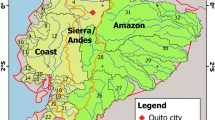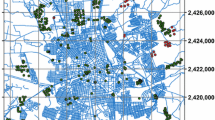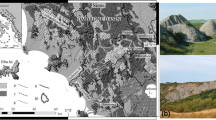Abstract
In the present work the result of the application of geostatistical methods to soil settlement data is presented. The settlements are induced by liquefaction as a result of an earthquake of magnitude 5.5. In the present paper the ArcGIS Geostatistical Analyst software was used, where a number of Kriging methods are available. Geostatistical analysis was performed on two phases: (i) modelling the semivariogram to analyse the surface properties and; (ii) application of a Kriging method. The best adjustment was obtained with a Gaussian model with a first order function trend removal. The settlement values were obtained from the analysis and treatment of results of SPT tests carried out on soils corresponding to alluvial soils in the urban centre of Leiria, Portugal. The results show a significant area where are expected large settlements that can generate significant damages in the building stock and infrastructures.
Access provided by Autonomous University of Puebla. Download conference paper PDF
Similar content being viewed by others
Keywords
1 Introduction
Liquefaction is consequence of earthquakes causing damages mutually to buildings and to infrastructures [1,2,3,4,5]. The occurrence of liquefaction depends on the earthquake’s properties and on the nature and geotechnical characteristics of the soils. Alluvial soils are susceptible to liquefying when located in regions where earthquakes of magnitude above 5.5 may occur. One way of analysing the possible effects of liquefaction is to estimate the settlements induced by it.
The geotechnical tests, like the standard penetration tests (SPT), allow to estimate these settlements, although they are usually isolated data and for urban planning or disaster management, the knowledge of it is spatial distribution is foremost importance.
The present study area corresponds to the alluvial soils of the Lis river located in the urban area of the city of Leiria (see Fig. 1), in the central region of Portugal. The Lis river has not always had the route that it follows today, the floods that occurred in the past led to the change of the original route of the river, having been displaced in some areas of some meters. With the development of the city, this old river bed was occupied by buildings. During the last years, the city continues to grow and any intervention, even in the built environment in this area requires the greatest attention, and the geotechnical characterization of the soils is fundamental. During the last years, numerous geotechnical prospecting works were developed in the case study area, with a large set of available geotechnical data.
The existing data allows to define in detail the lithostratigraphy and the geological structure of alluvial soils. According to the descriptions of the surveys, the alluvium appears to be underlain by embankments and pavements and they have a thickness between 0.5 m and 13.5 m. They are constituted by granular materials of varied nature (from clays in the top to gravels in the base), with little compactness and with groundwater table near the surface. When terrains with these properties are subject to vibrations they may suffer from liquefaction and vertical settlements or/and lateral displacements. In this work only, vertical settlements were considered.
Alluvial soils have geological properties that make them vulnerable to liquefaction being located along a zone of high seismic risk (Zone B) according to the actual building seismic code [6, 7]. According to Jorge [8] the alluviums of the Lis river are susceptible to high liquefaction potential and the region of Leiria is in an area with a minimum return of liquefaction occurring between 150 and 175 years.
2 Materials and Methods
2.1 Calculations of the Settlements from the SPT Test Data
To evaluate the settlements induced by liquefaction it is possible to use SPT data. In the alluvial of the Lis river, in Leiria, several geotechnical tests have been carried out, namely SPT tests. In this work, the SPT data used were obtained from geotechnical reports performed in the area corresponding to 73 boreholes. The SPT tests provide N values (number of blows required for the penetration of a standardized sampler) which were corrected according to NCEER [9].
A set of generic earthquake parameters, considering the past history [7] and the codes were defined, considering a maximum soil acceleration of 0.2 g [6] and magnitude 5.5 were defined. The settlements were calculated according to Robertson and Lisheng [10] proposed method. For this evacuation the GeoLogismiki computer application, LiqSVs1.1.1.8 was used as well as the N values, depth, layer thickness, fines content, and groundwater table position from the 73 boreholes.
The assessment procedure used follows five steps: 1. field SPT data are used for the evaluation of Cyclic Ratio Resistance which is the soil “strength”; 2. the seismic load is expressed through Cyclic Stress Ratio; 3. calculation of factor of safety against liquefaction; 4. estimation of post-liquefaction induced settlements and 5. estimation of the overall liquefaction potential [11]. The software implements the most commonly used calculation methods for both CSR and CRR, NCEER and Boulanger and Idriss [12].
The software allowed to obtain the settlement in each stratum of each borehole. The settlements were added and obtained the total settlement in each borehole and at every point. It was these settlement values that were analysed to construct the settlements map and the damage map.
2.2 Geographic Information System and the Kriging Methods
The Geographic Information System (GIS) tools are used for mapping and analysing data spatial distributions and to find out the liquefaction potential in the zones where data is not available. To determine the spatial distribution of a parameter, data interpolation is necessary. Some traditional interpolation methods, such as the inverse distance weighting method (IDW) and Kriging method, have been widely used to convert point data to spatial distribution. The IDW method is relatively fast and easy to compute but have estimation accuracies that are limited by their algorithms. By contrast, the Kriging method uses a variogram analysis to estimate the spatial variation structure and considers spatial autocorrelation. Kriging, like most interpolation techniques, is built on the assumption that things that are close one to another are more alike than those farther away.
The Geostatistical Analyst first determines a good lag size for grouping semivariogram values. The lag size is the size of a distance class into which pairs of locations are grouped in order to reduce the large number of possible combinations. The dialog box displays the semivariogram values as a surface and as a scatterplot related to distance. Then it fits a semivariogram model (best fit for all directions) and give its associated parameter values (nugget, range and partial sill).
The semivariogram has several features; the nugget effect, the slope at the origin, the range, the sill, and the anisotropies. The slope can be assessed from the first three or four variogram values; the nugget effect can be estimated by extrapolating back to the origin. The range can usually be assessed visually. The sill is set the value where the variogram stabilizes. Usually, a de-trending pre-process is applied to the observation data. After this pre-processing, the spatial distribution of the variable is assumed stationary, which means that the semivariance does not change with location. This function line is considered a model that quantifies the spatial autocorrelation of the data. Several models are available to fit the empirical semivariogram, e.g., spherical, exponential, Gaussian, linear and power models.
Geostatistical analysis has two phases: (i) modelling the semivariogram to analyse surface properties and; (ii) kriging. In this paper, we have used the ArcGIS Geostatistical Analyst where a number of kriging methods are available. The input dataset was explored to examine how the data is distributed and look for global trends.
Cross-validation gives you an idea of the goodness of model prediction of unknown values. For all points, cross-validation sequentially omits a point, predicts its value using the other data, and compares the measured and predicted values. The calculated statistics serve as an indicator weather the model is reasonable for map production.
The predictions were assessed based on cross-validation statistics: (i) mean prediction error; (ii) root mean square standardized prediction error; (iii) standard error, and; (iv) root mean square prediction error. The geostatistical interpolation technique Ordinary Kriging was used.
3 Results
In the present study, 11 semivariogram were tested with the Geostatistical Analyst Tool in ArcGIS ™. Data were adjusted to 33 semivariogram models (without and with trend removal through 1st and 2nd order functions).
Cross-validation was performed to verify the goodness of the semivariogram model predictions of the unknown values. Several objective functions were used to assess the model’s performance: (i) Mean error should be close to 0; (ii) Root-mean-square error and average standard error should be as small as possible; (iii) Root-mean-square standardized error should be close to 1; (iv) Mean prediction error should be close to 0 and; (v) Root-mean-square standardized prediction error should be close to 1.
In the data exploratory analysis, a downward trend in the East-West and North-South directions was detected, thus justifying the need to test the semivariogram models with the trend-removing functions (see Fig. 2).
Subsequently the semivariograms were hierarchize by attributing scores according to the results of the objective functions. The scores were added up and the semivariogram with the lower score is considered to have the best model’s performance in the cross-validation predictions of the unknown values.
The semivariogram selected was the Gaussian model (see Fig. 3) with the following characteristics: (i) Gaussian model, (ii) Trend removal – first order function, (iii) Lag number = 10, (iv) Lag size = 57.12, (v) Nugget = 169.74, (vi) Major Range = 490.23, and (vii) Partial sill = 172.23.
A settlement map was obtained for the studied area and is presented in Fig. 4. The settlement class between 20 cm and 30 cm is the one that occupies the largest area, around 48%. The areas with higher settlement values, around 20%, correspond to the historic city centre, where is present the old building stock and a in high density of buried infrastructures.
Map with settlements induced by liquefaction [13].
4 Discussions and Conclusions
Ishihara and Yoshimine [14] established the relation between damage extend and approximate settlements (Table 1), defining three classes. Based on the proposed classes, the map of Fig. 5 was derived. These map show that more than 67% of the studied area under a possible 5.5 Mw earthquake can suffer medium damage and 30% of the area can present extensive damage only due to the settlements induced by liquefaction in the building stock present in this area [15]. Past potential damages on buildings related with liquefaction can be observed in the historical data in centre of Portugal during the 1755 earthquake [16].
Map of the damage extend as function of settlement values [13].
The damage induced by the settlements depends on the size and type of the foundations and the nature of the materials and typology used in the building construction. According to EN 1997-1: 2004, in case of common structures with isolated foundations total settlements up to 5 cm are often acceptable, larger settlements may be acceptable provided the relative rotations remain within acceptable limits and providing that the total settlements do not cause problems with the slope or with infrastructures that access the structure.
The results of this study may be included in large risk studies in the area studies related with the survey of the exposed elements (buildings and infrastructures) allowing to have a proper definition of the risk level in these alluviums. The information generated is of great relevance to stakeholders to mitigate the risks associated with liquefaction and post-earthquake settlements.
References
Romão, X., Costa, A.A., Paupério, E., Rodrigues, H., Vicente, R., Varum, H., Costa, A.: Field observations and interpretation of the structural performance of constructions after the 11 May 2011 Lorca earthquake. Eng. Fail. Anal. 34, 670–692 (2013). ISSN 1350-6307
Gautam, D., Chaulagain, H., Rodrigues, H., Shahi, H.R.: Ground response based preliminary microzonation of Kathmandu valley. Geotech. Eng. 48(4), 87–92 (2017). Retrieved from www.scopus.com
Gautam, D., Forte, G., Rodrigues, H.: Site effects and associated structural damage analysis in Kathmandu valley. Nepal. Earthq. Struct. 10(5), 1013–1032 (2016). https://doi.org/10.12989/eas.2016.10.5.1013
Sharma, B., Siddique, A.F., Medhi, B.J., Begum, N.: Assessment of liquefaction potential of Guwahati city by probabilistic approaches. Innov. Infrastruct. Solut. 3(1), 11 (2017). https://doi.org/10.1007/s41062-017-0117-0
Singnar, L., Sil, A.: Liquefaction potential assessment of Guwahati city using first-order second-moment method. Innov. Infrastruct. Solut. 3(1), 36 (2018). https://doi.org/10.1007/s41062-018-0138-3
RSAEEP: Regulamento de Segurança e Acções para Estruturas de Edifícios e Pontes. Aprovado pelo Decreto-lei no 235/83, de 31 de maio. Porto Editora (2010)
Ferrão, C., Bezzeghoud, M., Caldeira, B., Borges, J.F.: The seismicity of Portugal and its adjacent Atlantic Region from 1300 to 2014: maximum observed intensity (MOI) map. Seismol. Res. Lett. 87(3), 743–750. https://doi.org/10.1785/0220150217
Jorge, C.: Potencial de liquefacção dos solos portugueses. In: Neiva, J.M., Ribeiro, A., Victor, L.M., Noronha, F., Ramalho, M.M. (eds.) Ciências Geológicas: Ensino, Investigação e sua História (Associação portuguesa de Geólogos ed., vols. II, Geologia Aplicada, pp. 331–342) (2010)
Youd, T.L., Idriss, I.M., Andrus, R.D., Arango, I., Castro, G., Christian, J.T., et al.: Liquefaction resistance of soils: summary report from the 1996 NCEER and 1998 NCEER/NSF workshops on evaluation of liquefaction resistance of soils. J. Geotech. Geoenvironmental Eng. ASCE 127(10), 817–833 (2001)
Robertson, P.K., Lisheng, S.: Estimation of seismic compression in dry soils using the CPT. In: Fifth International Conference on Recent Advantages in Geotechnical Earthquake Engineering and Soil Dynamics, San Diego, CA (2010)
GeoLogismiki. https://www.geologismiki.gr/Documents/LiqSPT/HTML/index.html. Accessed 22 Mar 2019
Boulanger, R.W., Idriss, I.M.: CPT and SPT based liquefaction triggering procedures. Department of Civil & Environmental Engineering, College of Engineering, University of California at Davis (2014)
Veiga, A., Mourato, S.: Geostatistical analysis of settlements induced by liquefaction due to two magnitude earthquakes: case study River Lis Alluviums (Portugal). In: WMESS – World Multidisciplinary Earth Sciences Symposium, Prague (2017)
Ishihara, K., Yoshimine, M.: Evaluation of settlements in sand deposits following liquefaction during earthquakes. Soils Found. 32(1), 173–188 (1992)
Gomes, T., Gaspar, F., Rodrigues, H.: Characterisation of building stock and its pathologies: case study of the historical city centre of Leiria, Portugal. In: Nondestructive Techniques for the Assessment and Preservation of Historic Structures, pp. 21–38 (2017). https://doi.org/10.1201/9781315168685
Tavares, A., Costa, A.: Efeitos do Terramoto de 1755 de Lisboa na Região Centro de Portugal, 10 Congresso Nacional de Sismologia e Engenharia Sísmica, Açores, Portugal, April 2016
Acknowledgements
This work is funded by National Fund through FCT – Foundation for Science and Technology under the Project UID/AGR/00115/2013 and in the Project UID/Multi/00073/2013 of the Geosciences Centre of the University of Coimbra.
Author information
Authors and Affiliations
Corresponding author
Editor information
Editors and Affiliations
Rights and permissions
Copyright information
© 2020 Springer Nature Switzerland AG
About this paper
Cite this paper
Veiga, A., Mourato, S., Rodrigues, H. (2020). Geostatistical Analysis of Settlements Induced by Liquefaction – Case Study River Lis Alluviums, Portugal. In: Correia, A., Tinoco, J., Cortez, P., Lamas, L. (eds) Information Technology in Geo-Engineering. ICITG 2019. Springer Series in Geomechanics and Geoengineering. Springer, Cham. https://doi.org/10.1007/978-3-030-32029-4_9
Download citation
DOI: https://doi.org/10.1007/978-3-030-32029-4_9
Published:
Publisher Name: Springer, Cham
Print ISBN: 978-3-030-32028-7
Online ISBN: 978-3-030-32029-4
eBook Packages: EngineeringEngineering (R0)









